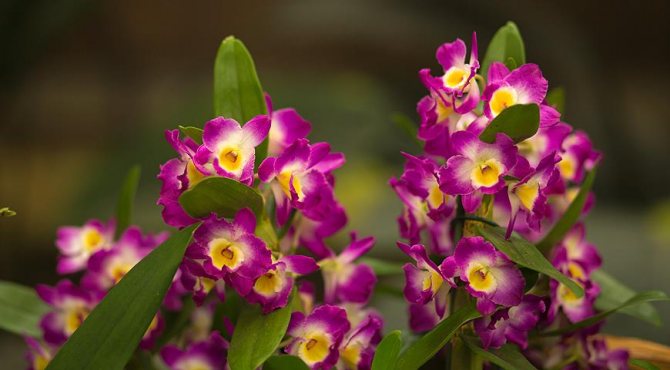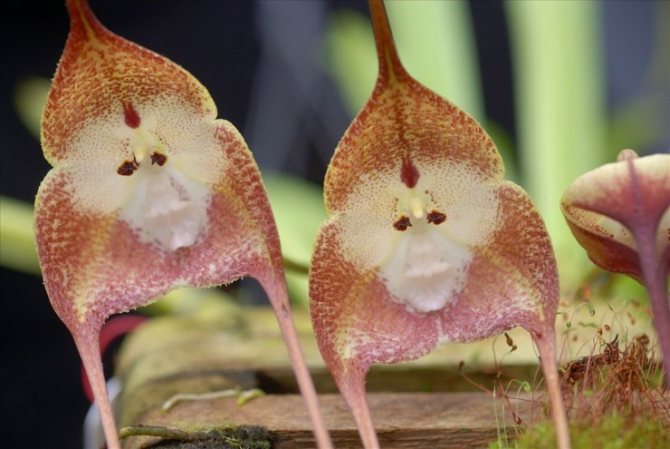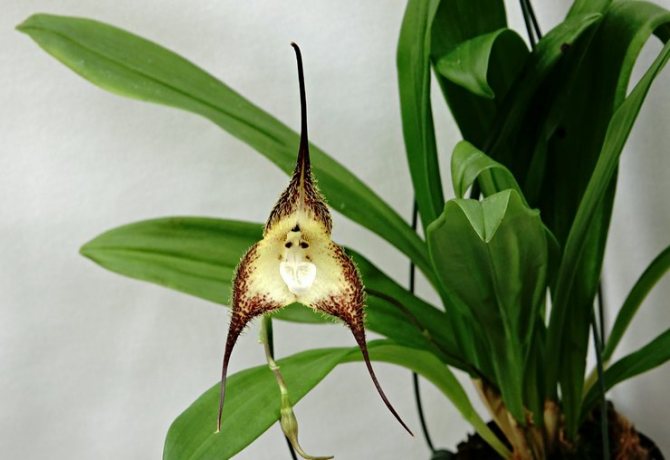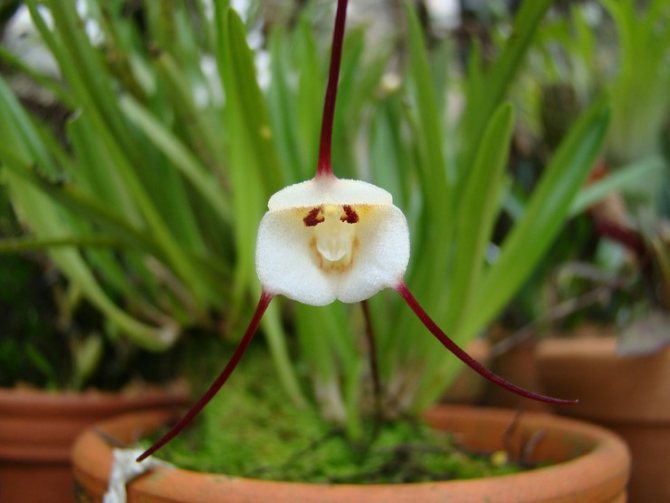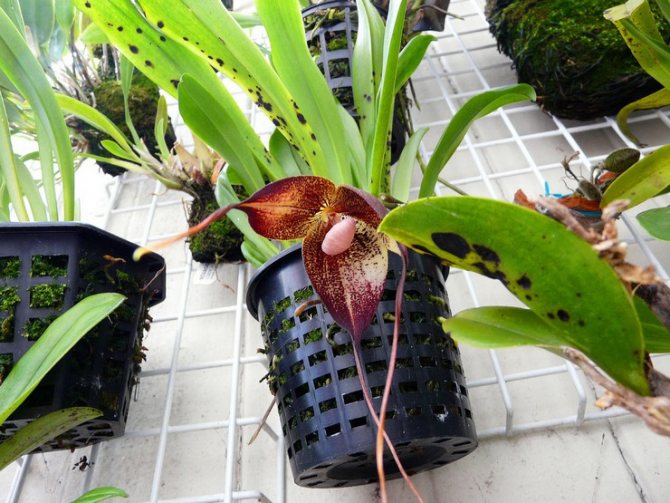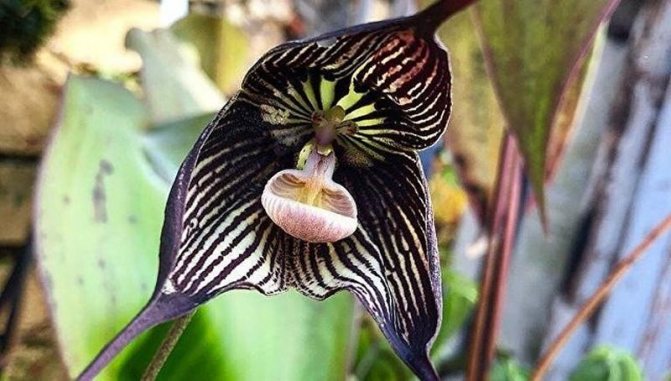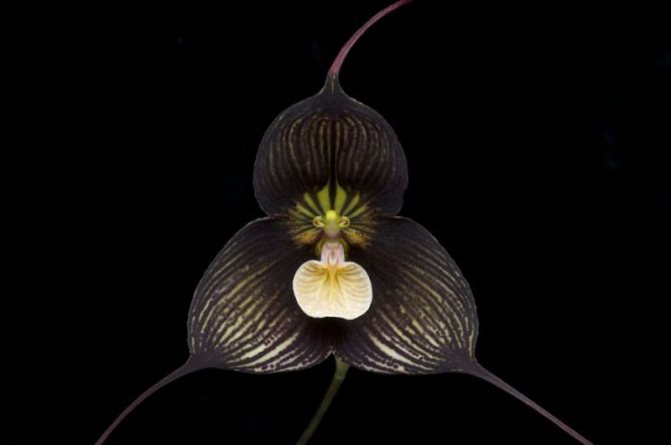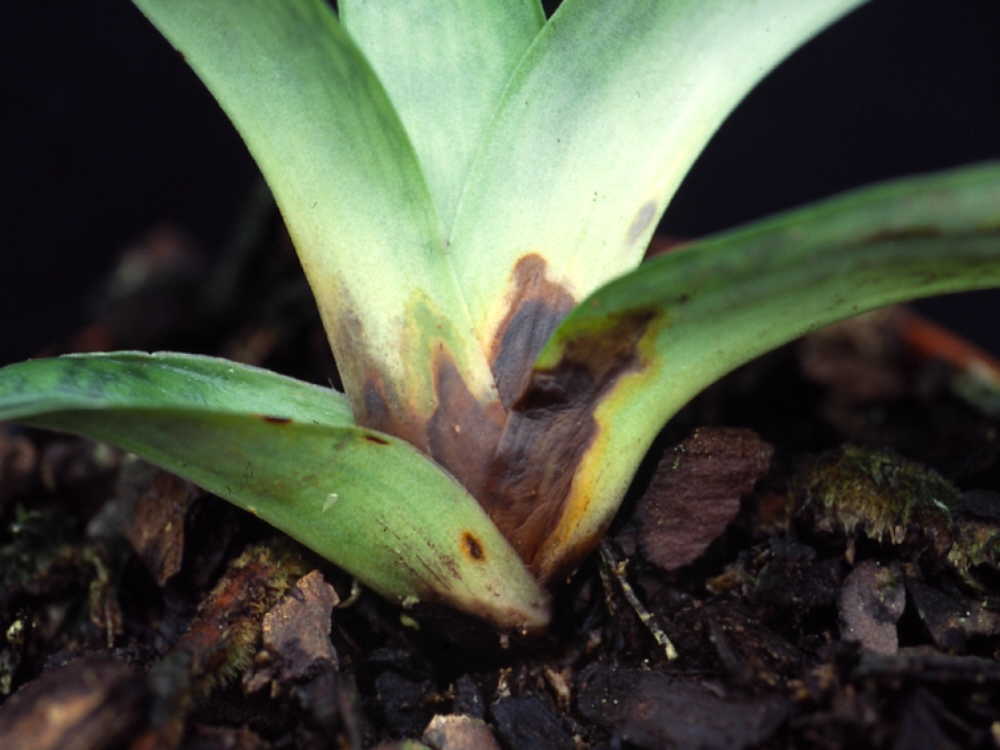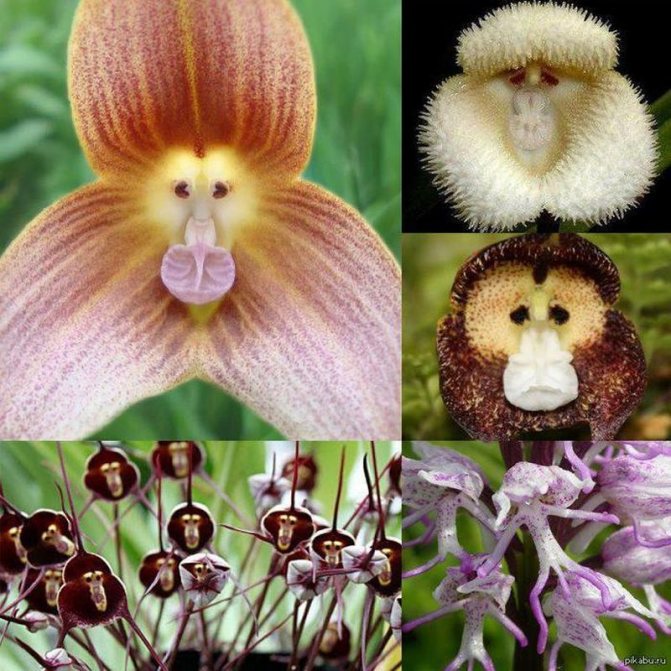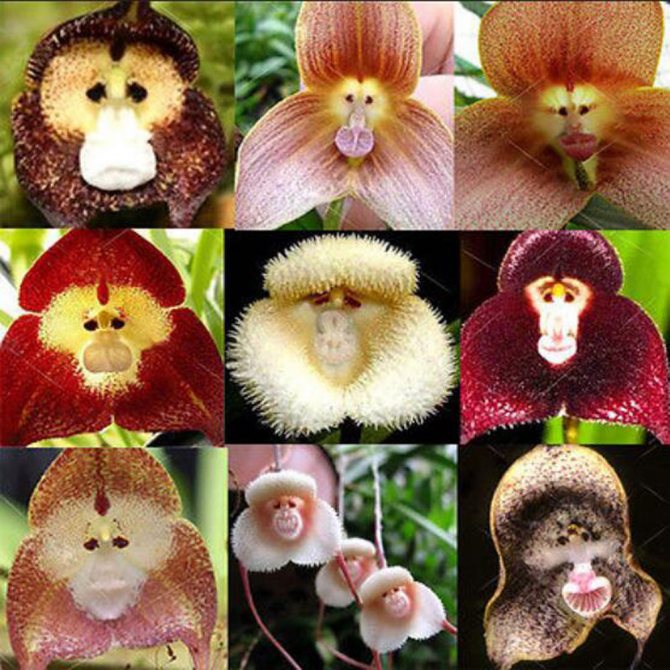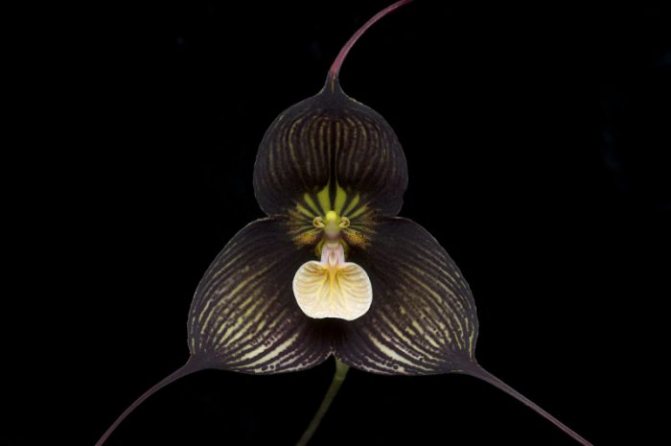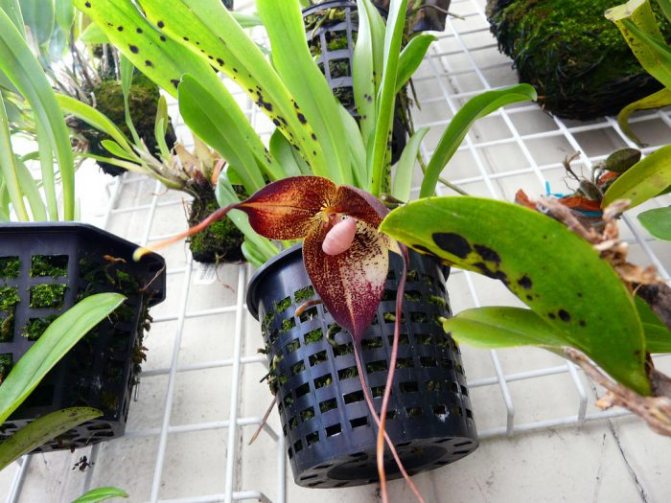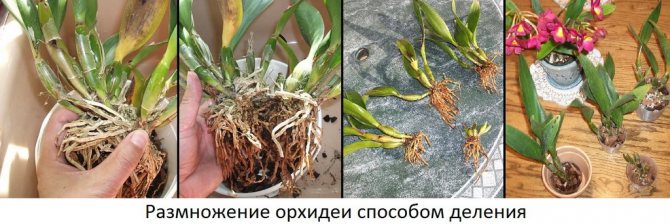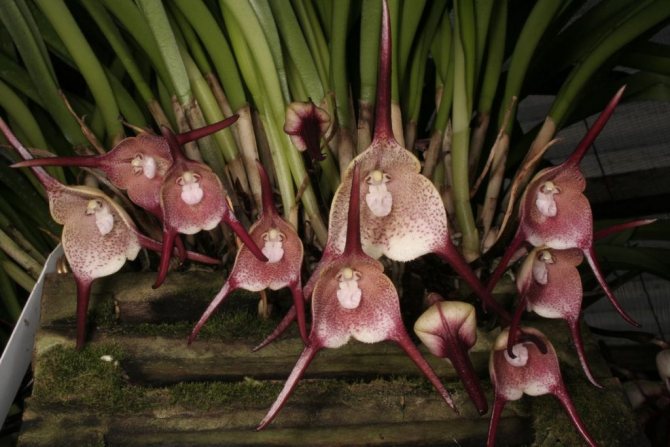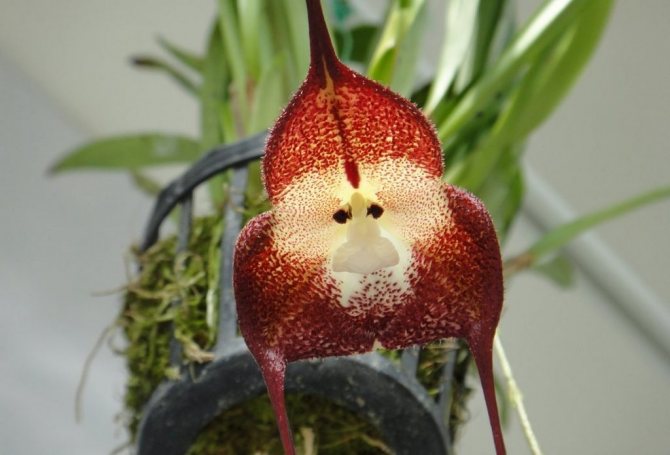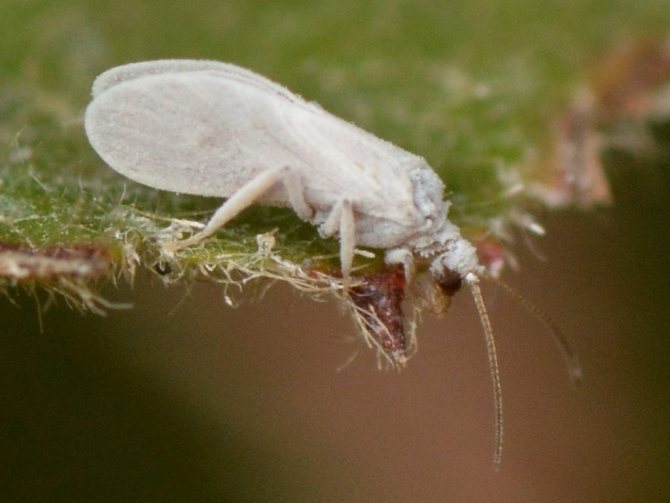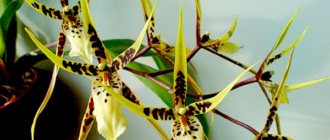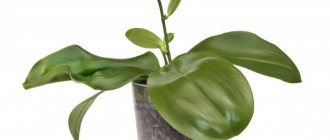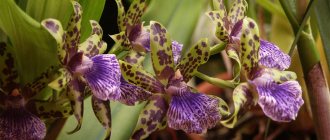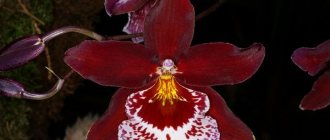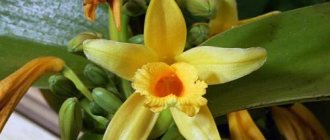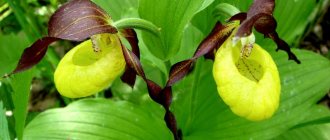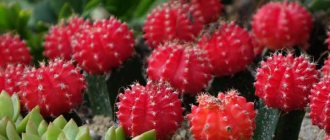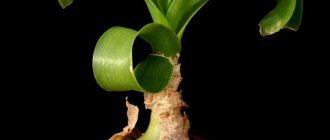Orchids Monkey face - description and care
They talk and write about these orchids with delight. This is necessary. Such beauty and so to call it.
Dracula - Little Dragon. Little dragon. The son of the dragon. And they are sure to start remembering the terrible shots with the famous movie characters from Transylvania.
The name of these orchids is due to their resemblance to another character. They thought that their appearance very much resembles the face of a small dragon. It's good that the adult didn't see him.
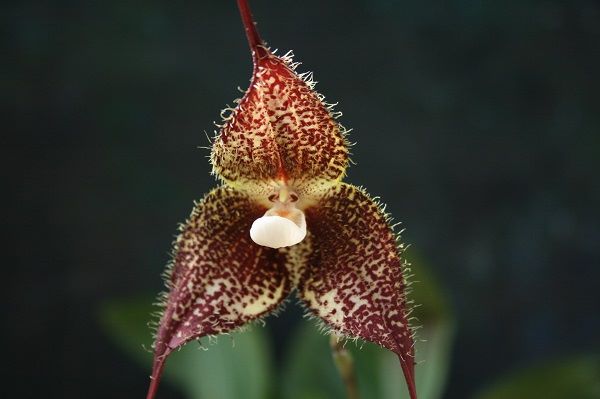
Photo of Dracula chimaera flower.
There is already more sentimentality:
- It was first described by Heinrich Gustav Reichenbach;
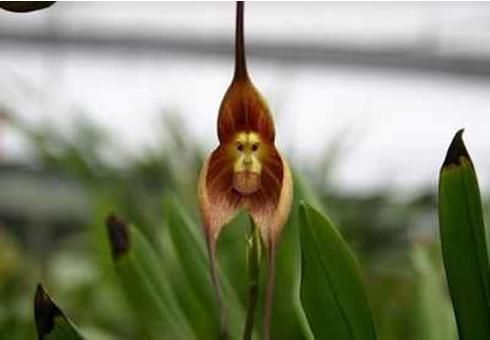

- His name was Masdevallia chimaera (its current name Dracula chimaera);
- And found in 1870 in the Cordillera orchid collector Benedict Roesenl;
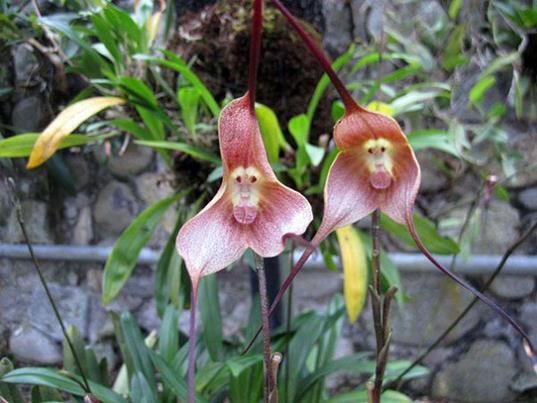

- But many species in the names have epithets in one way or another indicating evil spirits - Chimaera, Diabola, Fafnir, Gorgona, Gorgonella, Vampira, Nosferatu (chimera, gorgon, vampire, nosferata, fafnir);
- But Dracula simian "monkey orchid" is the most famous among them. And popular.
This genus belongs to epiphytic plants. They do not parasitize on other plants:
- Not so long ago he became independent;
- And earlier it was a member of the Masdevallia genus;
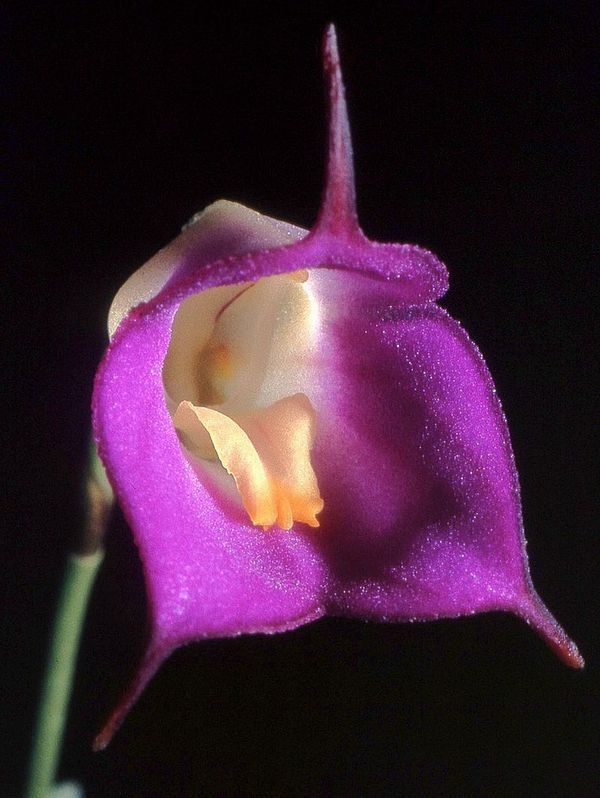

The Masdevallia uniflora flower is a type representative of the Masdevallia genus. - Now more than 120 species of this genus are already known;
- And almost 20 species are considered rare. Very vulnerable. And they are listed in the Red Book;
- Representatives of the monkey species have recently been recognized. Only in 1978 it was widely advertised by the botanist K.Luer (K.Luer). He found it in the high mountains in the southeast of Ecuador;
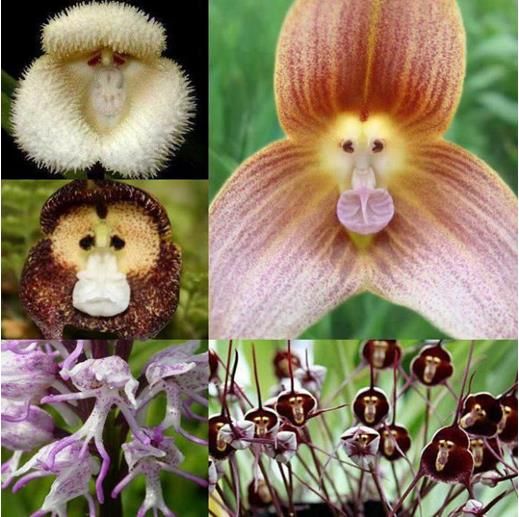

- Most of them are greenhouse flowers;
- Smell like fresh oranges;
- They are very demanding on the conditions of detention. Few succeed in this in apartments.
Planting and caring for the Dracula orchid at home
Growing an orchid with a monkey's face in houses is impossible without creating special conditions close to the natural environment of this plant. In an ordinary city apartment, it is very difficult to recreate the microclimate of a rainforest. Therefore, more often it is possible to grow orchids that resemble the faces of monkeys in a greenhouse.
Landing
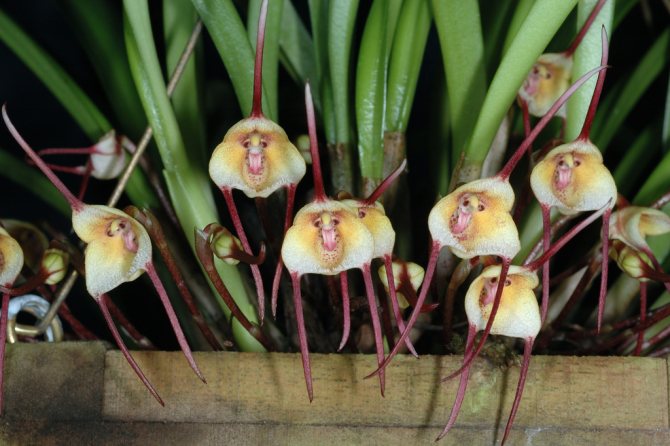

For the Dracula orchid, the soil is suitable, which is used in the cultivation of most epiphytes. It is based on pieces of pine bark, spruce or other conifers. A smaller proportion is accounted for by sphagnum moss and fine charcoal. You can add more pieces of fern bark and coconut fiber. Sometimes the monkey orchid is grown on blocks. Then Mexifern fiber is used with the addition of dried New Zealand moss. It helps regulate the moisture content of the substrate.
Dracula is planted in wicker baskets or plastic containers resembling them with a large number of holes:
- Drainage is laid at the bottom of the selected container and the walls are covered with moss.
- The prepared plant is placed in a container, gently spreading the roots.
- Fall asleep with a substrate.
- From above, the soil is covered with the remnants of moss.
If the Monkey Orchid has grown excessively and its root system does not fit in the previous container, a transplant is performed. Also, the reason for transplanting a plant is a deteriorated, compacted soil or a disease of the root system. A planned transplant is done in the spring, when the orchid is not blooming.
Temperature and humidity
To make it easier to care for this flower, you need to immediately create a comfortable temperature regime for it. Monkey orchid does not tolerate extreme heat and prefers to grow in relative coolness. For her, a comfortable temperature in the summer months is no more than +25 degrees. In winter, this flower will feel good at temperatures from +13 degrees.
Important!
An important condition for the timely formation of buds is the difference between day and night air temperatures. It should be no more than 4 degrees.
In the homeland of this flower, short-term rains very often occur, and in the morning there is almost constant fog. Therefore, the Monkey Flower is accustomed to high and constant humidity. For successful cultivation, you need to recreate a similar microclimate in your apartment. Any possible method is used to increase the humidity. At the same time, be sure to regularly ventilate the room. Stale air in conditions of high humidity becomes a favorable environment for the development of pathogenic microorganisms.
Illumination
In its natural environment, the monkey orchid grows in the lower tier of rainforest trees. In such thickets, sunlight is bright, but diffused. Therefore, when growing in an apartment, such a plant is created similar conditions and provide bright light, but so that direct rays do not touch it. The ideal place for the Dracula orchid will be windows on the east or southeast side of the house. In the north, as well as in the south, the flower is not left, since there is a high probability that the plant will overheat or freeze.
Watering and feeding
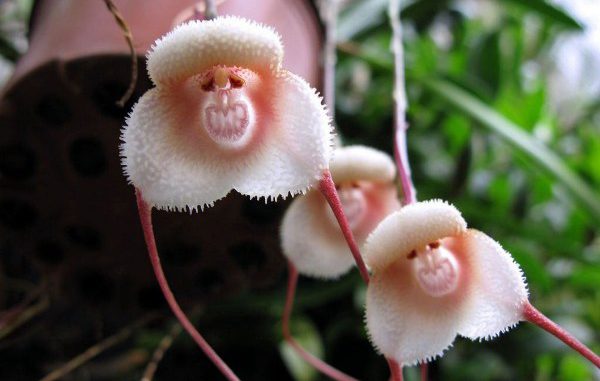

The frequency and intensity of irrigation largely depend on the created microclimate. In a warm and well-lit room, the plant needs an increased portion of moisture. Soft water is used for irrigation. You can use rainwater or spring water, distilled liquid will work as well. The soil in the container must be moist. But liquid stagnation is not allowed. This causes root rot. It is also not recommended to dry the soil too much so that the roots do not dry out.
It is most convenient to water the orchid by lowering it together with the container into a basin of warm water for 20 minutes. During this time, the substrate is saturated with moisture. Then the pot with the plant is taken out and left on the wire rack to remove excess liquid.
Top dressing is carried out constantly during the active growing season. For this, mineral complexes are used for growing orchid plants. Fertilizers are applied every two weeks, but if the weather is cloudy, one feeding per month is enough.
Important!
An excess of fertilizer for this flower is as harmful as a deficiency. Therefore, the dose recommended in the instructions is halved.
Care during and after flowering
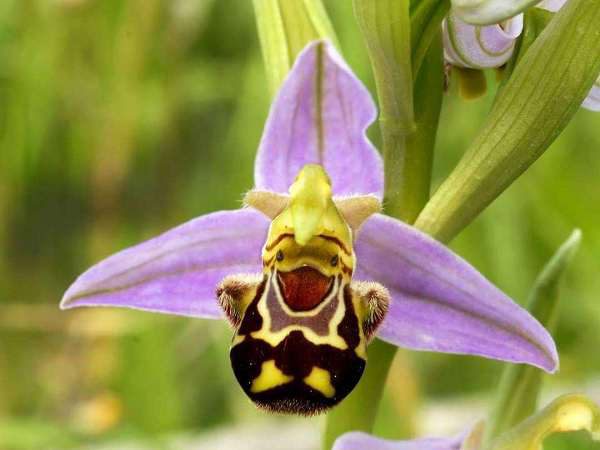

Dracula doesn't have a specific seasonality. Therefore, flowering occurs at any time of the year, if favorable conditions develop for that. The duration of this period is 15 to 20 days. To artificially stimulate the formation of buds, a difference between day and night temperatures of 4-5 degrees is created.
When the flower falls off, the peduncle is not immediately cut off. A new bud may appear on it. Only dried peduncles are removed.
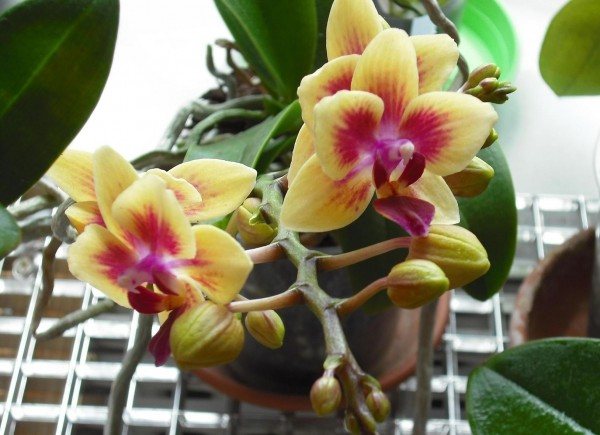

Territory of distribution in nature
In nature, the distribution area from the south of Mexico to Peru... Mexico, Guatemala, Honduras, Nicaragua, Costa Rica, Panama. But most of them are in the Central and Western Cordilleras of Colombia and in the west of Ecuador.
The places are hard to reach. For a long time they did not know about them:
- Wooded and inaccessible highlands. Height from 1500 to 2500 meters;
- Very high humidity... Tropical rain and fog are almost daily;
- Shaded parts or completely in the shade;
- Temperatures are low;
- In the lower part of large trees, they are more often found. At the level of human growth. And even on the ground.
And not all orchids that live in these hard-to-reach places are known to scientists. Even today.
Natural growing conditions
Most of the Dracula orchid species grows on the wooded slopes of the Cordillera mountain range. As a rule, they are located on the trunks of large trees, but they do not climb higher than 3 m from the ground.
For them, stability of conditions is very important, changes may not be tolerated: if a tree for some reason (thanks to a person or naturally) falls, then the orchid in most cases dies.
The natural environment surrounding Dracula is characterized by:
• frequent rains, • high air humidity, • low temperatures (cool in the mountains), • low degree of illumination (the sun's rays barely break through the leaves).
Most common colors
- It is rather difficult to describe the colors. Easier to scrutinize. Everyone has their own perception, imagination. And vision;
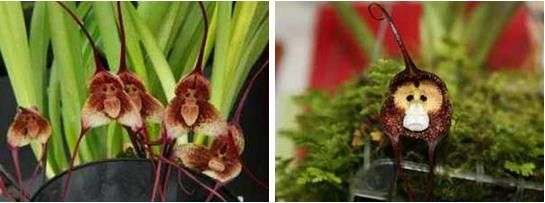

- Many doubt that these are natural flowers. Not props and good editing. Or photoshop;
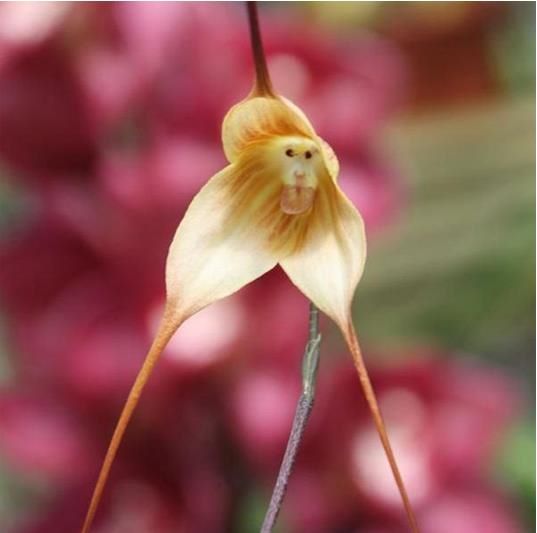

- Even those who saw them not only in the photo.
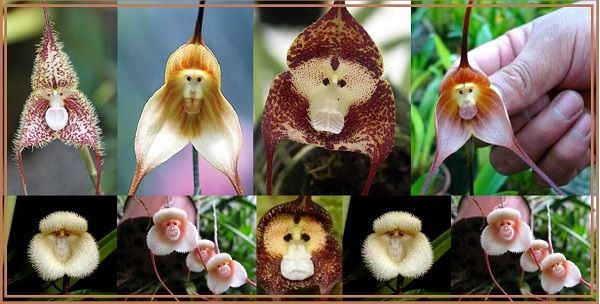

Some color options.
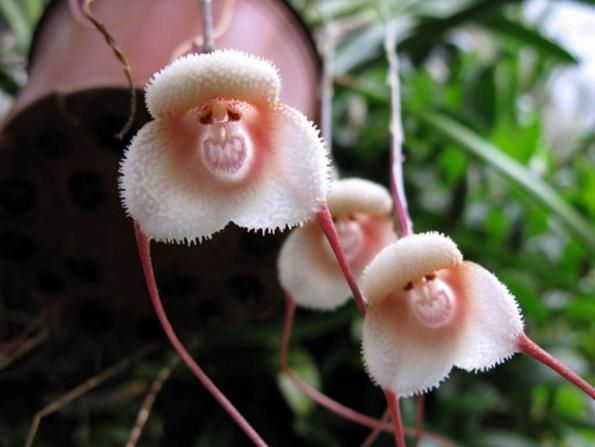

Watering
It is best to use soft rain, melt, or distilled water for irrigation. If you do not find one, then it will do from the tap, but only settled.
Be very careful with watering. Frequency and abundance directly depend on the level of lighting, temperature and humidity. The higher the temperature and the better the lighting (usually in summer), the more and more you water.
In wet and cold weather (fall and spring), water less and less frequently. Well, in winter, due to circumstances - one has an air conditioner, another has a humidifier, and a third has just a battery, in general, depends on the climate in your house.
The most important thing is that the substrate and roots should dry well and quickly between waterings. For example, it was watered in the morning, by the evening everything was dry or by the next morning (depending on the substrate). And after that, the orchid can stay dry for another 1-2 days. If she has good epiphytic roots, with a sufficient layer of velamen (and not soaked, excuse me, "snot"), then she will endure these 1-2 days calmly.
Testimonials
Milan. “Having seen this amazing plant, I decided to buy it for myself. I read a lot about her. She knew that she was capricious and fastidious. It was worth a lot of work. I will not tell. I have experience in growing other orchids. Once I picked them up, that they constantly bloom. Not simultaneously, but in turn. I assumed that the experience gained would be enough for the cultivation of other species. I have decent conditions for them. Equipped with a greenhouse. Though small. But with Dracula it did not work out. No matter how hard I tried. She disappeared from me. And I provided her with the conditions of detention corresponding to the nature of the habitat. All according to the recommendations. And she looked after as it should. I was upset for a long time. I don’t dare to make a new purchase yet. As I said, it is both very difficult and expensive. I'm afraid to get upset again. But Masdevalia is now with flowers. There are 7 of them. And this is the second flowering this summer. I put it in the garden for the whole summer. "
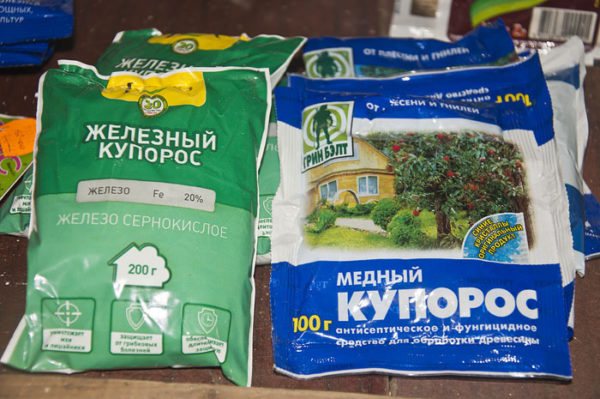

Elena. “These cute orchids with the menacing names of the vampire Dracula do not like any sun rays. I read that it is impossible to grow them in indoor home conditions. And only a few orchid collectors can be proud of them. Here I am among them. But I think that such statements are far-fetched and not entirely reliable. Even with a specific variety, this is permissible. And this is a whole species. That I know well. Dracula purchased and imported from Europe are almost doomed. I call this third-hand implementation. All transportation and outbidding bring the rhizome to a deplorable state. "Cocked in moss" and dumbfounded. Rotten roots are a trifle. Out of 7 Dracula and Masd, nothing was missing from me. They also bloom regularly. So a good purchase condition is already an achievement. And then your diligence and patience. I'm not the only one so moved by these orchids. But it turns out. "
Michael. “Dracula is one of the coldest orchid species. No heat, no sun rays.With buds and flowers, you are unlikely to get them. With new sprouts, it is quite possible. Even in summer, it needs to be supported in our heat no more than 25-26 degrees. And at night 17-18. We ourselves dream of such a temperature at night 32-33. And also compulsory ventilation. If you can create it, start it. Previously, you can build a small greenhouse. With air conditioning. Even the presence of a peduncle does not guarantee that you will see flowers. For two years they dried up and fell off. By the way about the peduncles. They tend to grow downward. So you need to keep an eye on. Flowers hold for a long time for dracula. Almost 3 weeks. If it's hot, less. Not all buds open at the same time. Only 2-3. But the Dutch Dracula orchids almost all came with spots. I took the scissors and cut them neatly. And very much. I left only 1-2 leaves. I watch and hope. "
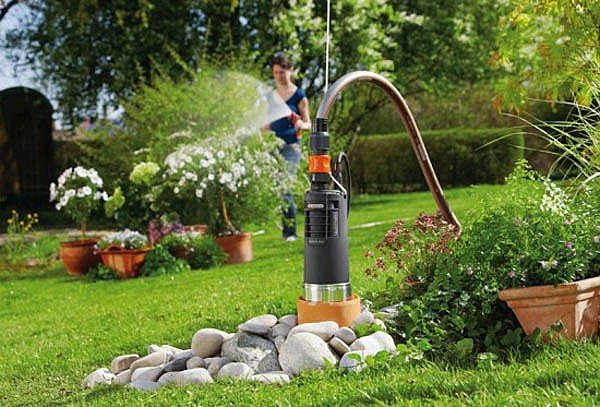

Temperature
Since Dracula belongs to the moderately cold group, the suitable temperature range for most species (except for the most cold-loving ones) is from +12 ° C to +25 ° C. Moreover, day and night temperatures must necessarily differ by 3-5 ° C - this stimulates flowering. By the way, such a small fluctuation is provided naturally on any windowsill.
Unfortunately, the Dracula orchid cannot stand the hot, dry climate. In summer, 25 ° C is already the limit! In the fight against overheating, an air conditioner or fan, as well as an equipped orchidarium, can help.
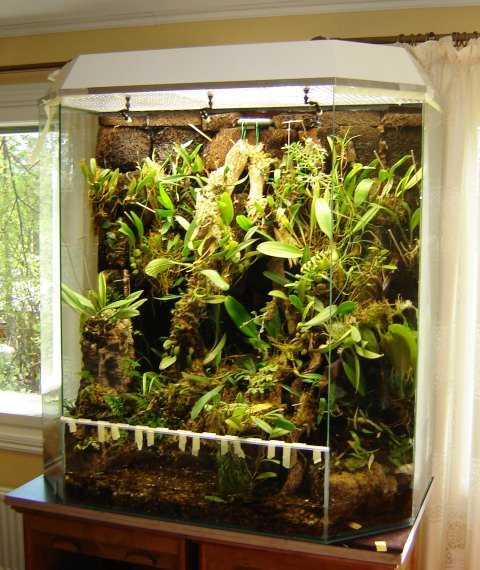

Botanical characteristics
Structure
- Short stems have long and narrow long leaves in the form of a belt. They are also arrow-shaped;
- Light green to dark. Shortened rhizome;
- They do not have pseudobulbs... Their role is played by leaves with a spongy structure;
- The peduncle has one flower. Grows from the sides of the stems;
- And further very small seeds.
Height of an adult plant
- Here they are unremarkable in height... Yes, they do not need it;
- Their attraction, uniqueness is different. In amazing flowers. Not everyone is able to see them with their own eyes.
Number of leaves
- The more leaves, the healthier the plant;
- When calculating maybe about 20... Small, medium and large.
Maximum peduncle length
- Peduncles are short about 5cm long... Straight or slightly drooping;
- They can even grow through the roots of the plant.
Diameter, flower shape
- Zygomorphic flowers. Quite small, 3-4 cm in diameter;
- Three sepals form a bowl;
- Their tips are highly elongated. They are longer than the flowers themselves. They are called outgrowths;
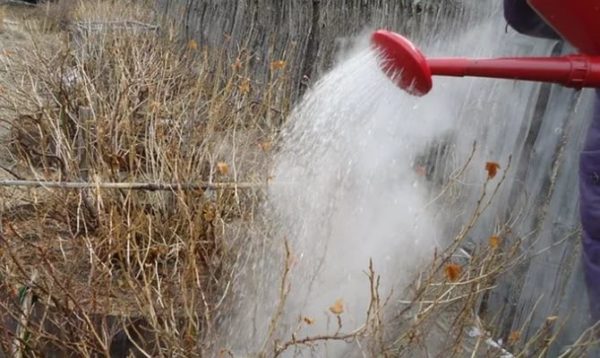

- If you look closely, you can see on them and hairs;
- The lower petal (lip) is larger and looks like a bucket;
- A column is located between the two fleshy petals. Here is the appearance of their flowers with color and gave them the name.
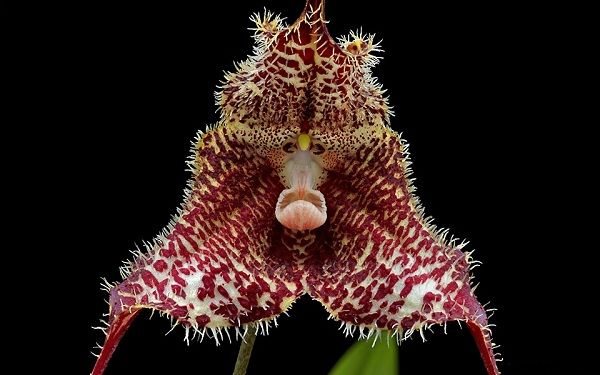

The structure of the flower.
Dracula orchid: transplant features
Dracula is a plant that does not require frequent, regular transplants. It is only necessary to transplant the plant when it grows strongly and the roots begin to bulge out of the pot, or when the substrate becomes unusable.
To transplant the plant, you will need a new clear plastic pot, a special substrate, sphagnum moss, and warm water.
You can buy soil for Dracula at any flower shop or prepare it yourself from pine bark (fine fraction), sphagnum, fern roots and charcoal.
Put moss in a pot with large drainage holes and add some of the substrate (about 1/3 of the total volume of the pot). Next, the roots of the plant are placed in the container, lightly sprinkled with soil and sprayed with warm rainwater from a spray bottle. Small plants can be tied to a support. After 3-4 days, spraying should be replaced with full watering.
This type of orchid can also be grown in coconut blocks. To do this, lay a layer of sphagnum on the bottom of the pot, put a fiber and cover with another layer of moss.With this cultivation, the orchid develops faster and, with proper care, practically does not get sick.
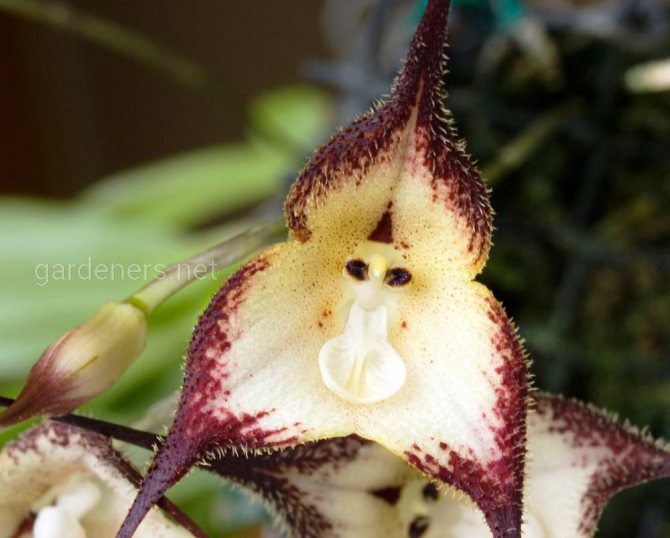

The main features of flowering
Period
How and when will it bloom? And how long will it last? Most asked questions. It all depends on the conditions. In nature, they do not have a well-defined flowering period. Some are fading. Others are blooming.
Duration
- Some are fading. Others are just beginning to form buds;
- These amazing monkeys are looking at you two or three weeks;
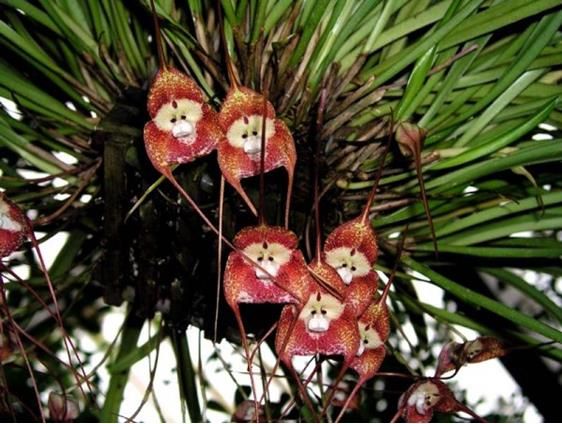

- The rest period is not for her.
Stimulation
- For the emergence of new buds and flowers temperature fluctuations need to be regulated;
- So that during the day it was 4 degrees higher than the nighttime.
How to water and maintain moisture
Rains, fog, dew - all this is in nature for Dracula. Any change in climate destroys the plant even in its natural environment. It is difficult to keep the humidity of 70-85% in houses. A humidifier, air conditioner and fan (for air circulation) will help. So that fungi, rot and microorganisms do not multiply - airing.
Important!
The soil should always be moist without stagnant water in the bowl. On days when it is hot and light, watering is more often carried out.
Room temperature is best for watering, soft water:
- thawed;
- rain;
- filtered;
- defended.
Water must be free of chlorine, so as not to burn the leaves (stains will remain). The pot is placed in a tray and watered with a watering can until the water completely covers the ground. The roots should be saturated with moisture within 20 minutes. After that, the pot is removed from the pallet so that the excess water is glass.
Maintenance and care
Optimal conditions
- As indoor culture this orchid is one of the most complex. Only in the greenhouse can you create conditions for her. Including with the help of fans and air conditioners;
- Experienced orchid growers and specialists say this;
- And they add. Many of us can afford to have their own winter garden. Pool. And a good greenhouse;
- And many like to surprise with a curiosity;
- With such an original plant with monkey flowers you can dumbfounded.
Lighting and backlighting:
- Here she, one of the few orchids, does not need bright lighting;
- Lives in nature in the shade and partial shade;
- Afraid of direct sunlight;
- But with phytolamps it feels great.
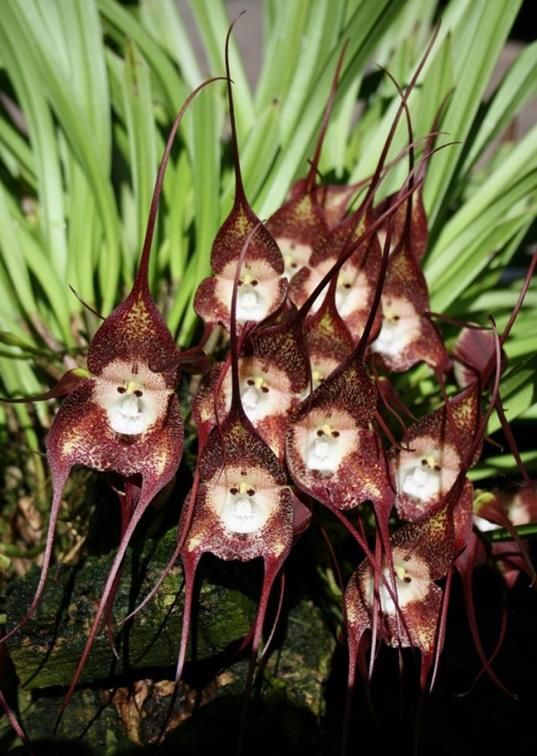

Moderate or even low temperature suitable for Dracula:
- In the summer 18-24 degrees;
- In winter - 15-17 ° C;
- But not below 12-13 ° C;
- And stick to the rule. The morning temperature should exceed the evening temperature by 5-6 degrees;
- This is just necessary for the formation of peduncles and buds.
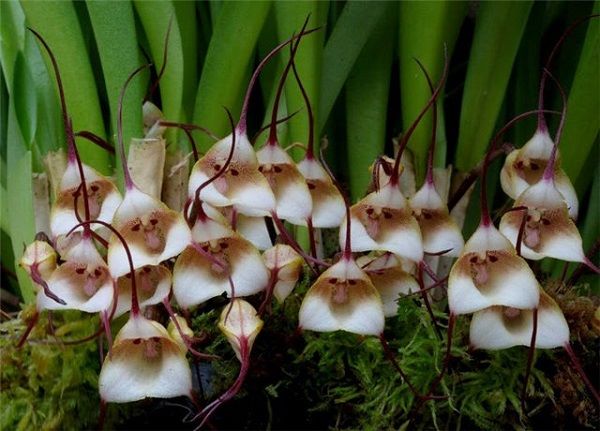

For flowering, Dracula needs a temperature difference.
Advice! Tropical rains create high humidity in habitats. So you support 70-90%. And also the obligatory airing of the room.
Watering
- A basket (pot) is placed in a prepared container with water. Until the substrate is completely immersed;
- 25-30 minutes is enough... Roots receive a complete diet. The air is leaving;
- Place on the grate to keep excess moisture;
- Before the next watering, the soil must be allowed to dry;
- The water used is soft: Rain;
- Thawed;
- Defended;
- Boiled;
- Pass through the filter;
- Room temperature;
- Chlorine residues can cause leaf stains
Root and foliar dressing: timing of introduction, alternation
- Need to feed. During the growing season;
- Frequent feeding is not required... An excess of them is more harmful than a deficiency;
- Use the purchased fertilizers carefully. Even Reduce the recommended proportion by half.
Post-flowering and dormant care
- Do not rush to cut the peduncle after flowering;
- It can still form a bud. And more than once;
- Cut off only dried ones.
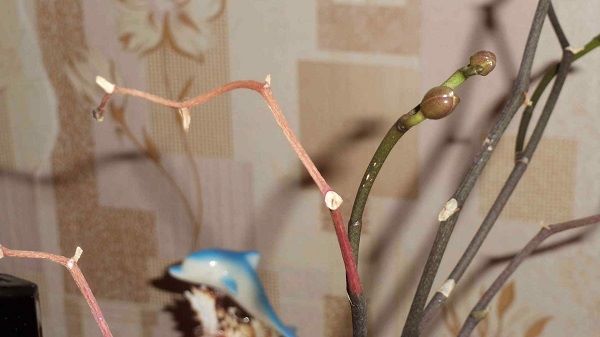

Only a completely dried peduncle is cut off.
Prevention of diseases and pests
- Correct care behind the plant in the conditions appropriate for this type allows you to achieve the main goal - the flowering of the orchid;
- Any miscalculations can lead to diseases;
- And even the appearance of pests.
Illumination and temperature conditions
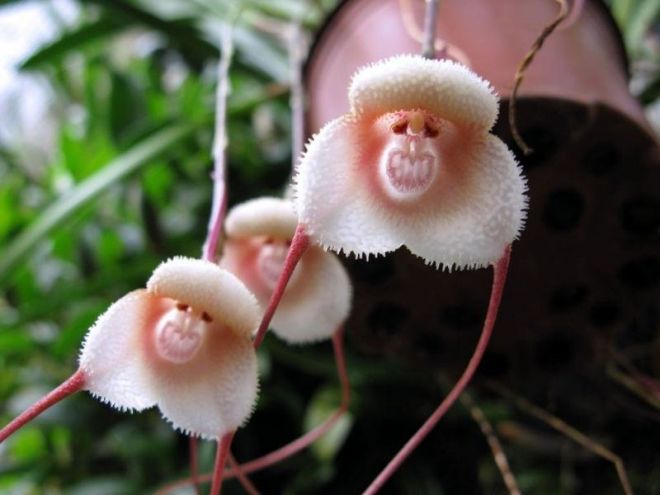

Having created the right conditions: light, humidity, watering and other parameters, you can grow a Dracula orchid at home. In wildlife, the flower grows in hot climates, but at home everything is different. The monkey loves diffused light, and cannot stand the scorching sun. Window sills, especially on the south side, will not suit her (drying out, burns).
The plant does not react well to heat. Prefers cool, shaded and humid environments. It is better to create lighting with artificial lamps (it is impossible to completely leave without light). In summer, you need to maintain a temperature not higher than 25 C, in winter - from 12-15 C not lower. If it gets warmer than 26 C, the orchid will stop drinking, but will "sweat" and dry out. In a hot and stuffy room, the buds will fall off without opening. Fresh air is a must.
For buds to set, it should always be 4-5 degrees cooler at night. It is the drop that contributes to their appearance.
Landing
Priming
The soil for most orchids is also suitable for this type:
- The bark of coniferous trees. Better are their small fractions;
- In smaller proportions, charcoal and sphagnum moss. Even finely chopped fern;
- Coconut fibers (shavings) are often used;
- Such an orchid is also successfully grown on blocks. In this case, Mexifern fiber is used. And dried New Zealand sphagnum.
Important! It is with this species that one often has to deal with such a soil component. It can be indispensable for maintaining moisture. Know how to use it correctly.
Optimal capacity
- Wicker baskets. With small cells;
- Similar options are available in plastic.
Technology
- Prepare good quality soil and container of your choice. You can buy all this in specialized stores;
- Install drainage. The walls of the containers are neatly lined with moss;
- Prepare the plant and place it in the container. Spread the roots;
- Cover with substrate carefully;
- Cover the top of the soil with the same moss.
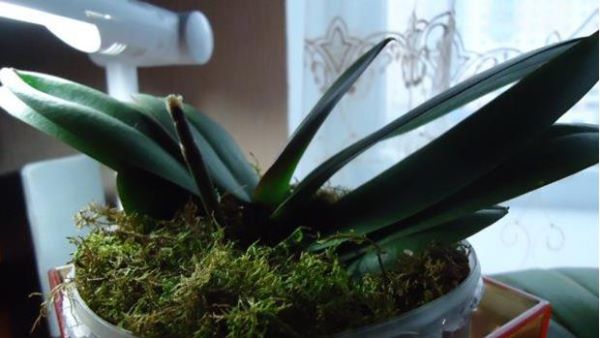

Timing
- You need to transplant the plant with its excessive growth;
- This is also recommended for highly compacted or spoiled soil;
- You need to do in the springtime. Before flowering.
Dredging and replanting
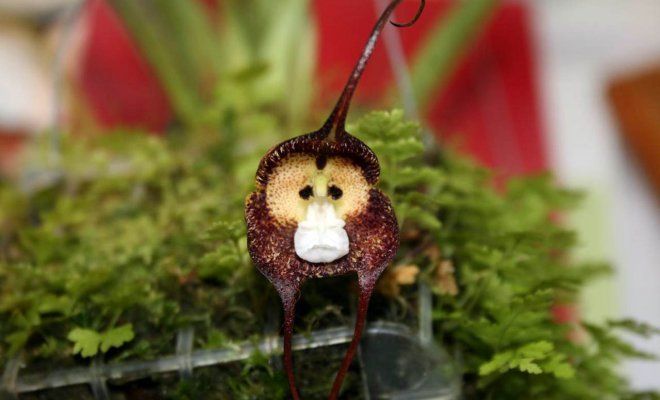

Often Monkey orchids cannot be transplanted, you need to monitor its growth and properly care for it. Spring is the best time for transplanting, when the greenery grows rapidly, young shoots sprout roots even before flowering, or when caking, compaction of the soil. Pots, plastic containers for aquatic greenery, wicker baskets are suitable. They are filled with an earth mixture (substrate):
- sphagnum;
- coarse peat fibers;
- some sand;
- charcoal;
- chopped bark of a coniferous tree.
Soil acidity 5.5-6.5 Ph. Cover the top with a thick layer of live sphagnum.
On a note!
Cultivation is practiced on blocks without using soil. In this case, watered in the morning (the roots should dry out until evening).
The main problems of cultivation
Basic rule for Dracula orchids:
- Once installed in one place, do not touch it;
- Do not rearrange;
- Don't swap sides;
- She is very sensitive to the change in conditions. And for the worse.
It's important to know! Dracula orchids usually die even when the trees on which they live are blocked. Excessive watering and dry conditions are equally dangerous for her.
Decay of roots
Root decay can be caused by:
- Your miscalculations in watering and feeding;
- Poor quality substrate requiring replacement;
- It can also be infections from other plants.
Overdrying
- Even short-term overdrying will lead to yellowing of the leaves and their drying out;
- Prolonged drought can lead to death;
- It is necessary to correctly assess his condition and correct mistakes in care.
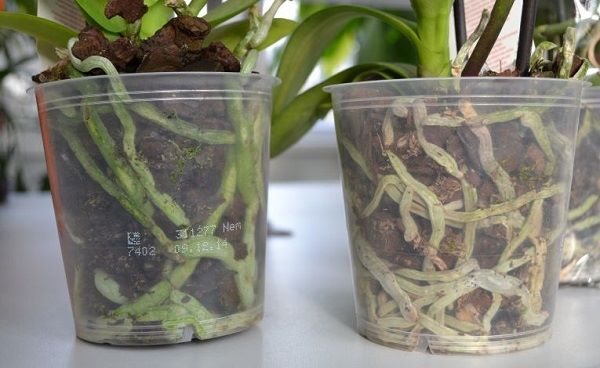

Do not overdry orchid roots.
Microbial diseases in the absence of ventilation
- Airing air at high humidity and low temperatures is simply a must;
- Stagnant cool and humid air can lead to the appearance of various microbes. It's theirs favorable environment;
- Air conditioners, fans, and ajar windows can help avoid these troubles.
Top dressing, dormant period and how to propagate
Home care for the Dracula orchid implies the need to feed it with special organic fertilizers. This should be done during the active growing season, regularly, every 3rd watering and 50% of the amount recommended by manufacturers on the package. The orchid is less often watered in autumn and winter when it is cool and dark during the daytime - once a month. An excess of feeding will have a detrimental effect on the flower.
The orchid does not have a dormant period, so you only need to cut the peduncle when it has dried. After flowering, the buds form again. When the peduncle is removed, the Monkey's face needs planting in a different soil and care (reduce watering, observe).
Reproduction of a raised monkey occurs only vegetatively. From seed – in greenhouses. An adult, overgrown mother bush is divided with a disinfected tool. Each part (plot) should consist of 4-5 shoots. Smear the slices with charcoal powder or cinnamon. The soil is the same as for adult flowers. Planting takes place in separate pre-prepared pots.
Common diseases, their treatment and prevention
- Scientists count "only" 32 types of pests for orchids;
- And also more than 90 fungi, bacteria and viruses;
- They are capable of causing various diseases of leaves, roots and flowers in your plants. These are: Leaf spot;
- Various rot (black, gray, brown, fusarium);
- Anthracnose and others.
Spider mite, thrips, aphids
Here's who you will have to deal with to protect your favorite flowers:
- Thrips Is a very serious pest. You will not see them at once: Signs - silvery color and dots-excrement;
- Means of struggle. Acaricides (Aktellik, Omite, Fitoverm, Aktofit).
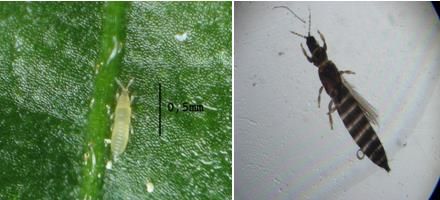

Thrips.
- Signs of appearance - small white dots on the bottom of the leaves;
Remember! Periodic spraying with garlic infusion is recommended as a good preventive measure against many orchid pests.
Fungal infections
- Upon detection of the first signs of the disease (brown spots, drying out, rot) the plant must be isolated from other flowers;
- Remove all affected parts of the plant;
- Use Fundazol, Topsin-M for the prevention of fungicides. Copper oxychloride;
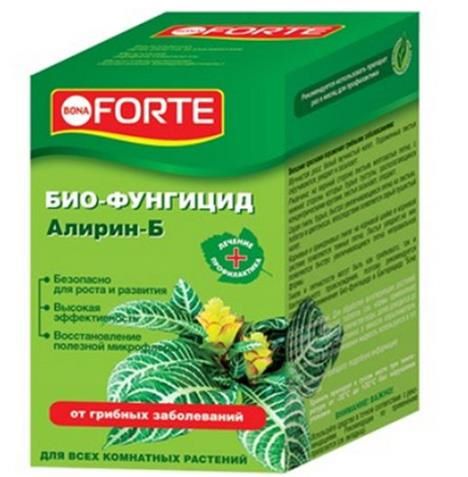

- Optimize the conditions of detention to the recommended ones;
- High humidity and temperature contributes to their emergence and development.
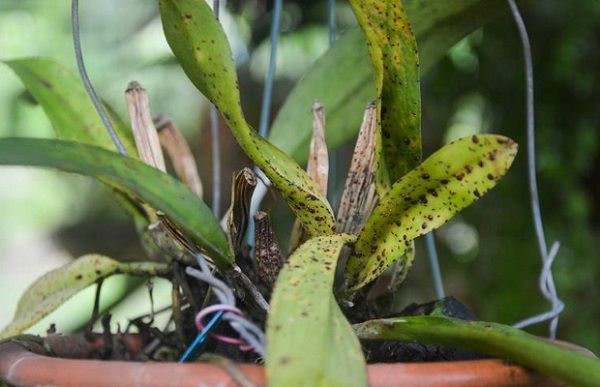

If a fungus is found, the orchid is immediately isolated.
Bacterial rot (or brown rot)
- Watery brownish spots;
- They spread quickly (increase) at low temperatures;
- Small ones can be cut. Treat with crushed charcoal;
- Use for prophylaxis preparations containing copper (copper oxychloride, copper sulfate);
- If not found in a timely manner, you will have to part with the plant so that others do not get infected.
Dracula orchid propagation
In our latitudes, Dracula is propagated exclusively in a vegetative way. To do this, an adult plant is divided into several parts so that on each division there are 4-5 shoots with active buds.
Reproduction of Dracula is as follows: a pot with an orchid is immersed in water for a few minutes, the plant is removed from the pot and the rhizome is cut into several parts, trying not to damage the aerial roots. Further, the places of the cuts are treated with crushed coal and the cuttings are seated in pots.
The first 3-4 days after planting, the plants should be sprayed on the leaf, moistening and nourishing the soil mixture. After that, caring for the sprouts is no different from caring for adult plants.
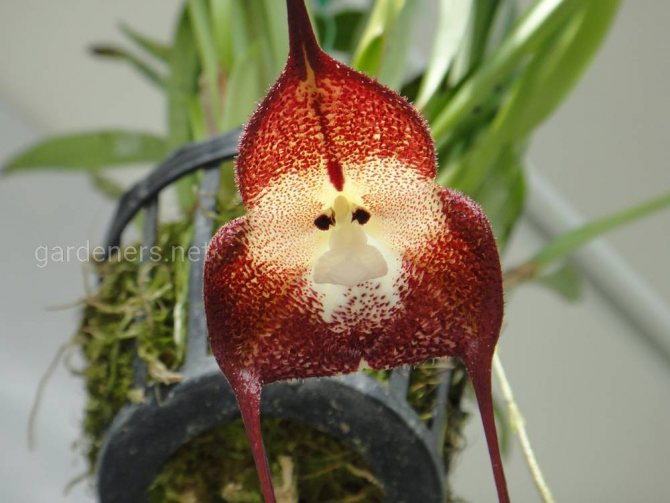

Maintaining humidity
In the latitudes where the orchid grows in nature, there are short-term rains almost every day, in the morning there is fog that settles with dew on the leaves. Dracula is used to moisture. Therefore, it is important to make every effort to bring the cultivated plant as close as possible to the microclimate in which it was created.
Try to prepare the room for growing the monkey orchid as much as possible. In addition to maintaining humidity, ventilate the room with a winter garden regularly, since a humid, stuffy room is an ideal environment for the mass reproduction of fungal diseases and bacterial infections that infect plants.
Orchid resuscitation
A dried plant is taken out of the ground, cut off all dry roots and leaves
and placed in a glass of water so that the neck is immersed in water. The water is constantly changing. When new roots and shoots appear, the orchid is planted in the ground.
Reanimation in water is the easiest way, but there are others.
If the roots are rotten due to overflow
or for other reasons, the plant is taken out of the pot, all rotten roots are cut out, dipped in crushed coal and planted in a new substrate, placing sphagnum moss on top. The orchid is constantly sprayed, creating high humidity, watered only two to three days after planting.
Choosing a place in the house
In order for the plant to develop in a full-fledged way, do not put the flowerpot with the Monkey on the windowsill. The thing is that such an orchid does not tolerate open sunlight, and in summer it does not tolerate high temperatures. In addition, the root system of a flower may dry out, which will not have a very favorable effect on its development. An orchid called a monkey will certainly delight you with its amazing flowers, if you provide competent care for it and choose a place that is optimal for its growth.
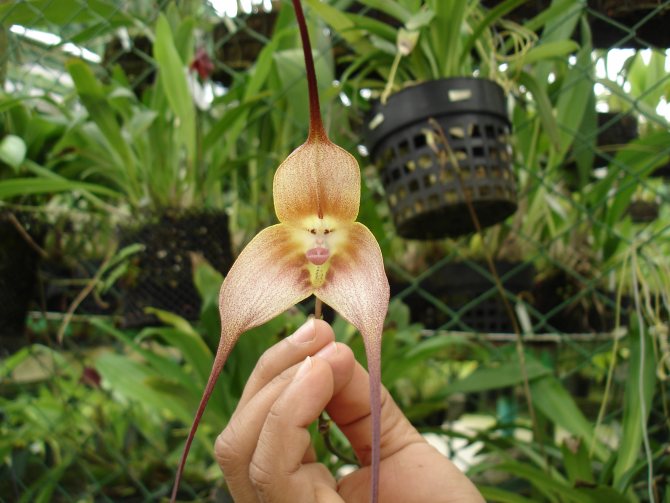

Dracula: what kind of flower is it, features of the species
You may be interested in: How to care for orchids in a pot after purchase Why orchid leaves wither and how to save it Features for the care and reproduction of Dendrobium Nobile orchids
The flower called "monkey orchid" is an epiphytic plant. In the jungle, it grows on old tree specimens. All species, which number about 120, have short central shoots and elongated belt-like leaves. Pseudobulbs are absent, but in some varieties, spongy leaf plates perform their functions.
The main feature is the structure of the flower. Shape, color, size can vary greatly. But any inflorescence of the Dracula orchid has three sepals, the base of which turns into a single bowl. The elongated tips of the petals resemble vampire fangs, which gave rise to the name "Dracula". The flowering phase can occur at any time of the year, but only with proper care.
Varieties: description and photo
Sodiroa
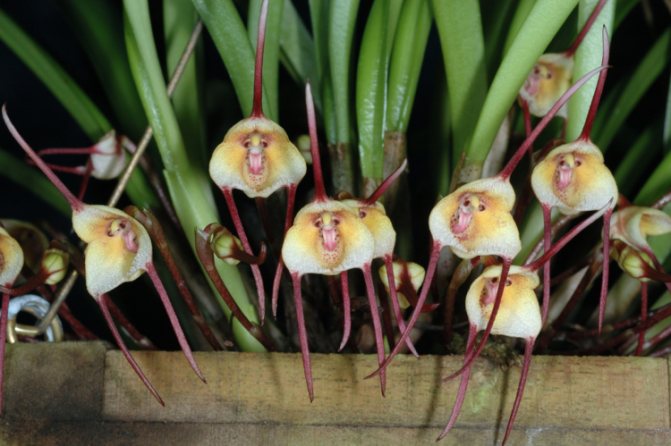

It belongs to a monotypic subgenus and has one species - Dracula sodiroi.
Xenosia
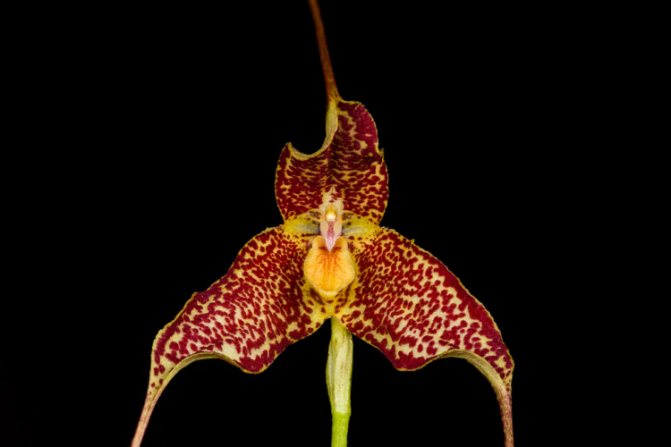

It is a monotypic subgenus and has the species Dracula xenos.
Dracula
Beautiful and lovely
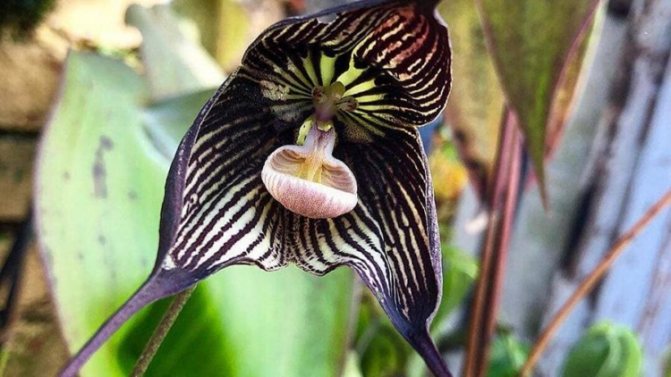

Also called Bella. Flowers of a chocolate-crimson hue, the inner part of which is highlighted with a yellow glow. Some experts compare flowers to spiders. The lip is split in two, which distinguishes it from other orchid subspecies. Bella grows on trees and on the ground.
Polyphemus
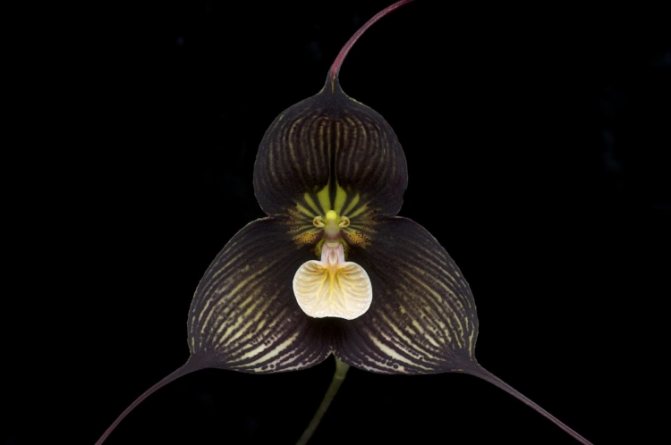

It is named after the one-eyed Cyclops from Homer's Odyssey. It has a spotted hood of lilac sepals and a pale lilac lip. Above the lip are small modified petals, between which there is an androecium.
Bellerophon
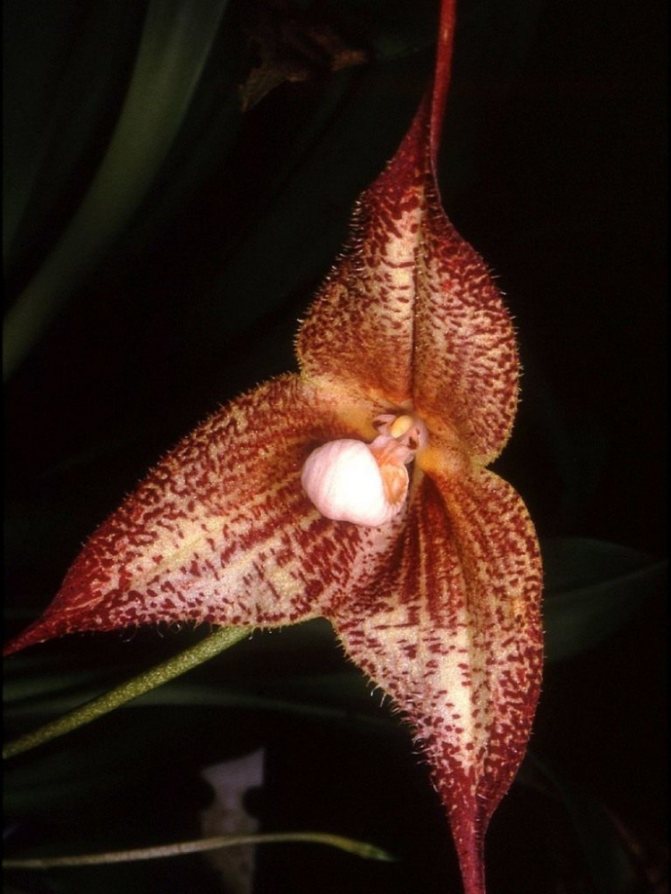

Named after the mythological hero of Greece. In nature, it can often be found next to the chimera. It differs from the latter in fluffy pale hairs throughout the space of light pink petals with spots.
Chimera
Backhousiana
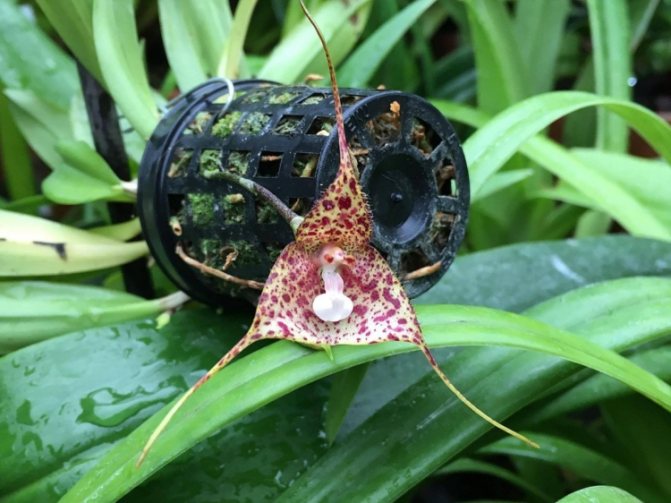

Sepals are rounded and accrete, the flowers are less speckled and the shade is paler than the typical species. The tails are short, about forty centimeters in diameter.
Senilis
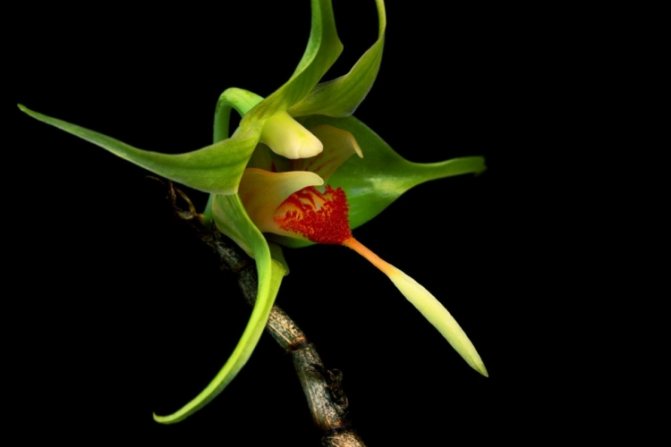

The flowers are smaller than the typical species.It has an orange spot in the center of the wreath and a white lip.
Stupenda
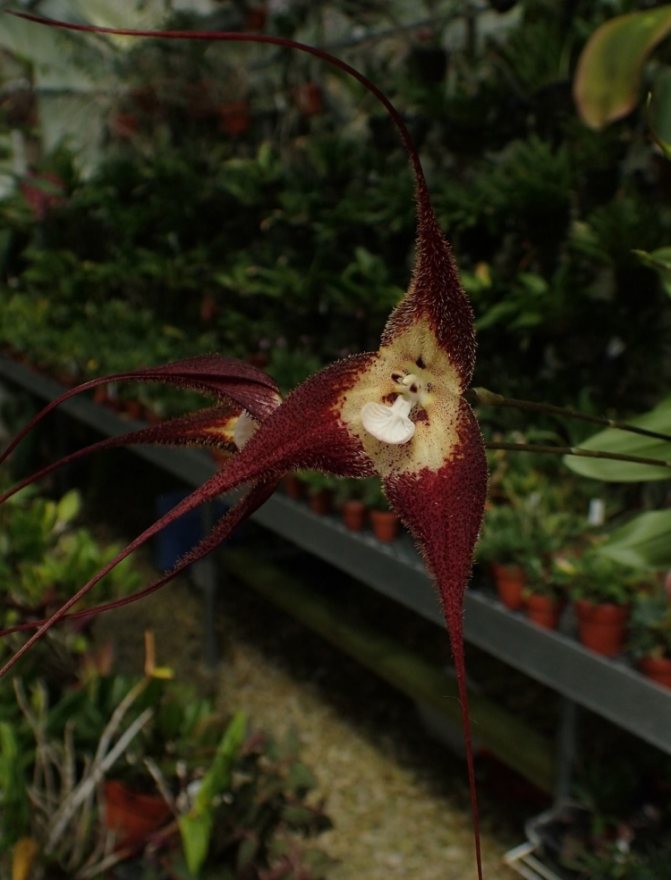

It is the most graceful of all types. Flowers are presented in a gray shade interspersed with chocolate color.
Pests and the fight against them
Monkey orchids are exposed to many diseases and pests:
- whitefly;
- aphid;
- herbivorous mites;
- shield;
- fungus;
- thrips.
To combat thrips, a solution of garlic is used: 700 g of unpeeled garlic bulbs are finely chopped, 10 liters of boiling water are scalded and boiled for about 4 hours. After it is filtered and diluted in 1 liter of water.
Against whitefly, spray with calendula tincture. To get rid of aphids and scale insects, wipe the leaves with a solution of laundry soap. To do this, stir 150 g of grated soap in 1 bucket of water.
A bit of history and a brief description of the Dracula orchid
Dracula belongs to the type of epiphytic plants that grow mainly on trees, or rather on the lower parts of their trunks, and sometimes on the ground. This orchid species is native to the rainforests of Central and South America.... The flower grows most often in mountainous areas at an altitude of 1-2 thousand meters above sea level. It was first discovered in 1870 by an amateur and collector of orchid plants, Benedict Roeznel.
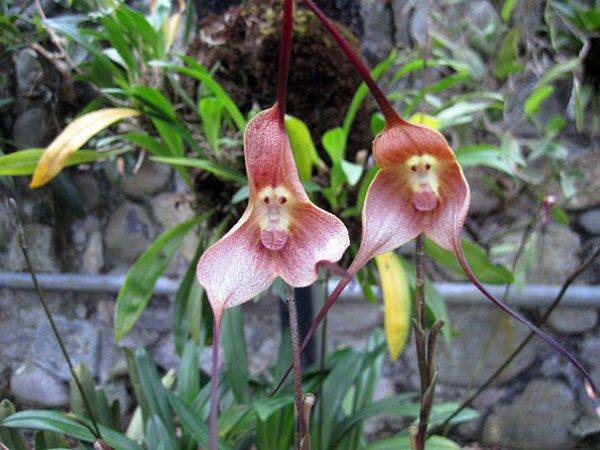

Monkey Orchid or Dracula Orchid
There are approximately 120 varieties of the Dracula orchid. For the most part, these plants are low, do not have pseudobulbs, but at times their purpose is performed by belt-like leaves of a rich green color, in some species these leaves have a spongy structure. Peduncles are mostly vertical-even, with some orchids slightly drooping, intertwined with aerial roots. The number of flowers on one peduncle, in many species, is equal to one.
The flowers of various types of monkey orchids differ in shape and color, but the point of contact for them is that the petals in the amount of three pieces are combined so that they form a bowl. The edges of the petals are narrowed and stretch far outward with a thin tail. They are often covered with hairs. Flowers of all kinds, except for petals, also have a so-called lip..
At home, this plant is not very common, unlike phalaenopsis, since they do not tolerate the abundant light of the sun and summer high temperatures, which are characteristic of some regions of our latitudes. Dracula's bloom does not obey the seasons and comes at any timeif you adhere to the correct care.
Bloom
When and how?
With proper care Dracula is able to bloom at any time of the year several times.... Flowers do not need a dormant period and special conditions during the flowering period. In natural conditions, the plant blooms from June to August.
Care features
Dracula does not need special care before and during flowering. When the peduncle begins to fade, it is removed. If necessary, the plant is transplanted. To adapt the orchid, it is placed in dry soil.
Dracula belongs to the revolving bloom type. It is necessary to remove faded buds in time so that new flowers form on the peduncle.
What if it doesn't bloom?
Flowering can be activated by artificial temperature changes... At night, cool the temperature five to six degrees lower than during the day. From May to September, the orchid can be kept on the balcony. So, the plant will be given a natural drop in temperature at night. It is recommended to use artificial light in winter.
Photo
Next, you can see in the photo what the dracula orchid looks like:
"Dracula Sodiroa"
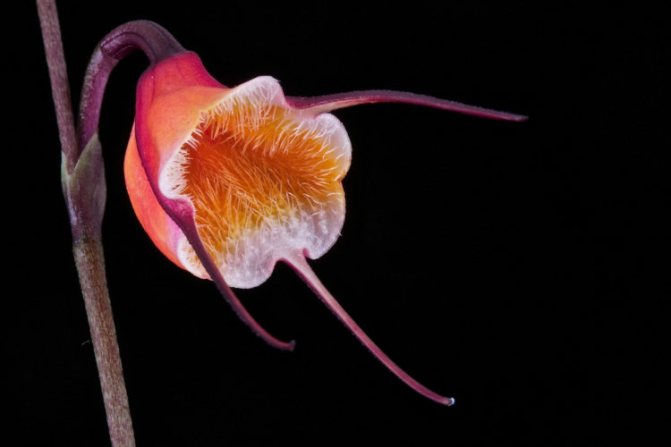

"Dracula Xenosia"
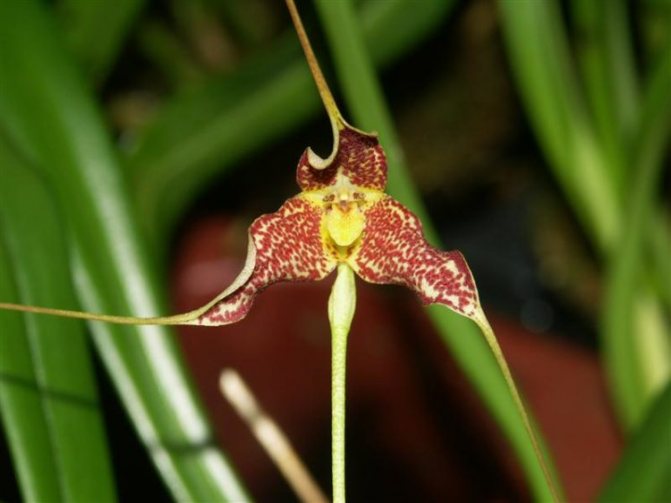

"Dracula Dracula"


Orchid of the genus Masdevallia
Masdevallia
(MASDEVALLIA)
Is a large genus with about 500 species of epiphytic and lithophytic orchids growing in Peru, Ecuador and Colombia. The genus got its name in honor of the Spanish botanist and physician of the late 18th century, Dr. Don Jose de Masdevall. The first species of the genus Masdevallia was found by European botanists in 1779 during an expedition exploring the forests of Peru and Chile.
Masdewallias - orchids form a strongly shortened creeping rhizome, on which thin, almost completely reduced pseudobulbs sit. Each carries a single rigid sheet. Most types of masdevallia bloom as single flowers, which are distinguished by a wide variety of shapes, sizes and colors.
As you can see in the photo of Masdevalia, the structure of the flowers is rather unusual: the sepals are usually very elongated and end with long threadlike ends. Several flowers usually open on a plant at once.
Many representatives of the genus and hybrids with their participation are popular in indoor floriculture.
For example, Masdevallia Falcata is the primary hybrid resulting from a cross between Masdevallia coccinea and Masdevallia veitchiunu. It belongs to the most popular and vibrant plants, mainly with bright orange and red flowers.
And one of the new hybrids, Masdevallia Baby Doll, is an abundantly flowering orchid suitable for growing in a small pot.
Masdevallia Aquarius
(Masdevallia davisii x Masdevallia constricta)
- an orchid with lemon-yellow flowers, about 3 cm in diameter, without elongation at the tips.
Masdevalia is the favorite orchid of the Peruvians, the unofficial symbol of Peru. The image of this orchid is present in the tales, songs and legends of the ancient Incas. In the flower of Masdevalia, Peruvians see an eye that cries, but these are tears of happiness! Hence the local poetic name for Masdewallia - "the eyes of the forest".
In culture, they require special content, but growing them, in principle, is not difficult. Plants do not have pseudobulbs, they accumulate moisture in the roots and succulent leaves, so it is preferable to grow them in pots. A substrate based on sphagnum moss is suitable for them.
When caring for Masdevallia throughout the year, it is necessary to provide a cool regime and diffused lighting (no direct sunlight). Top dressing throughout the year in low concentration.
Diseases and pests
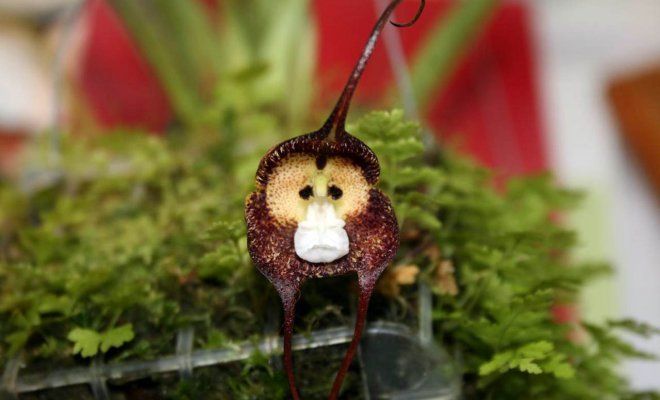

Like other epiphytes, Dracula is susceptible to infection with many diseases and parasites. The greatest danger to these plants is thrips. It is very difficult to get rid of them. We have to transplant the plant into clean soil with the obligatory disinfection of the container and treat it with chemicals. The best way to prevent the appearance of thrips is preventive spraying with garlic infusion.
Another parasite that infects the monkey orchid is the whitefly. This small insect starts in the summer months, settles on leaves, lays eggs. The hatched larvae feed on the sap of the plant. To get rid of the whitefly, insects are removed mechanically by washing the plant with warm water and cleaning it off with a cotton swab. The treatment is carried out by spraying with calendula infusion.
It may be interesting Coleus: species and varieties with a description, cultivation and care at home Why does not an orchid bloom and how can I fix it? When will an orchid bloom? Aphids on an orchid: causes of appearance, methods of control, prevention
Aphids are carried by ants. Leaves affected by these small insects curl up into a tube, covered with a sweet, sticky bloom. They are combated by washing the plant with soapy water. Another dangerous pest is the scale insect. It can be removed with the same soapy water and sunflower oil.
The main danger to orchid monkeys is infection with rot and fungal diseases. From them the plant becomes covered with spots. For the treatment of these diseases, the plant is treated with preparations of fungicidal action.
The plant is negatively affected by any changes in the microclimate or position of the flower. Therefore, once having placed the plant in a place suitable for it with a favorable microclimate, it is not recommended to move it or change the conditions of detention. From this, the plant will definitely get sick.
Shine
The Dracula Orchid naturally grows in the lower tiers of tropical forests. But do not forget that in tropical latitudes, the brightness of the sun is much higher than in average. Therefore, it will be optimal to provide bright, but diffused lighting, but not the scorching sun.
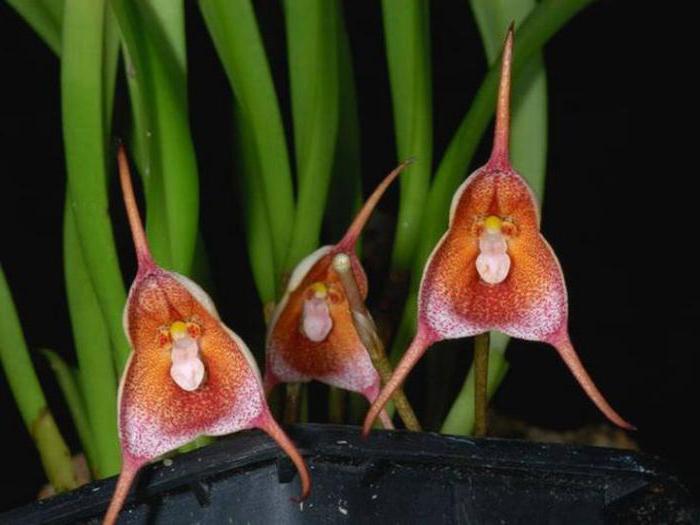

The ideal place to keep such plants is the southeast window sills. South-facing windows are not suitable: there is a danger of overheating of the orchid.
The most unusual plants with amazing appearance
The similarity of some colors with unexpected things is sometimes quite striking. Meet another amazing flower: Psychotria elata
of kind
Psychotria
sometimes called
"Hot lips"
for a strange shape, reminiscent of lush female lips, painted with bright red lipstick.
The plant can be found in tropical rainforests of Central and South America, in countries such as Colombia, Costa Rica, Panama and Ecuador
... The plant has developed such an unusual flower for the sole purpose of attracting pollinators, including hummingbirds and butterflies.
Unfortunately, the plant was endangered due to the uncontrolled destruction of forests in the countries of its growth. The flower of this psychotria looks like a kiss only at the very beginning
before it fully unfolds.
Another cunning orchid - Ophrys insectifera
learned to increase her chances of pollination with her strange appearance. Her flower surprisingly resembles a female insect, and
males flock to her and mate with a flower
, naively believing that this is a pliable female.
Moreover, to lure the insect, the flower exudes a special smell that mimics the female pheromone
... As a result, both the male and the orchid are satisfied, except, perhaps, the females.
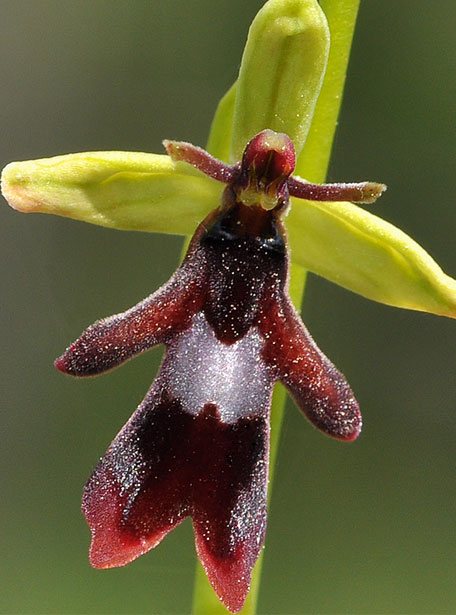

Succulent plant Stapelia - Stapelia flavopurpurea
- boasts a uniquely shaped flower that
very similar to a starfish
... Most flowers of this genus exude a very unpleasant smell of rotten meat, which attracts pollinators.
Stapelia flavopurpurea
- an exception, the flowers of this plant have
the smell of beeswax
.
Dracula is not one species, but a whole genus of orchids, and there are 123 species in it
(some call the number 126). Its homeland is Ecuador, where the greatest species diversity is also observed. Some species can be found in Mexico and Peru - this is the northernmost and southernmost boundaries of the genus.
ATTENTION
: Despite the scientific name, the specific color and shape of the lip (a petal modified in a special way) give most of the flowers a resemblance not to a dragon, but to a monkey's face. Therefore, the second, unofficial name for dracula is monkey orchid.
Another characteristic feature of dracula is the absence of pseudobulls.
(special fleshy formations, similar to bulbs, in which epiphytic plants store moisture). In part, the functions of pseudobulbs are taken over by loose, spongy leaves.
For the first time a representative of the genus Dracula was described in 1870 by the botanist Heinrich Gustav Reichenbach. This flower amazed the researcher with its unusual shape, for which it received the name "chimera". Initially, it was assigned to another genus - Masdevallia, but in 1878, on the basis of other finds, the Dracula genus was separated from the Masdevallia genus, and the "chimera" was assigned to it, receiving the scientific name Dracula chimaera.
The genus is divided into three subgenera, of which two are monotypic (consisting of one species):
- Dracula sodiroa
- it includes the only species Dracula sodiroi. - Dracula xenosia
- it includes the species Dracula xenos. - Dracula dracula
- this subgenus includes all other species.
"Dracula Sodiroa"
"Dracula Xenosia"
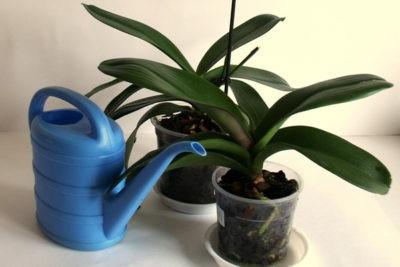

"Dracula Dracula"

